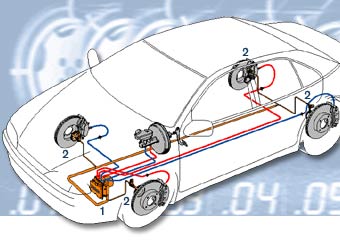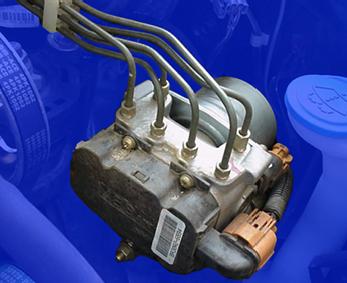Chapter 17: ABS Brakes
These days it is almost impossible to buy a new car or SUV for over AUD$16,000 that does not come standard with ABS.
These vehicles come standard with one of the greatest road safety innovations since seatbelts. This is Anti-Lock or Anti-Skid Braking Systems or ABS. The ABS system consists of a sophisticated hydraulic until controlled by a state of the art computer system. The computer system receives input from electronic wheel speed sensors located at each wheel.
During a panic stop a driver in a non-ABS equipped car, can reach wheel lockup, meaning that the car is skidding, increasing braking distance and meaning that the car cannot be steered. Through panic and the over-application of the brakes, the driver has become a passenger, without any control over the vehicle.
In the same scenario with an ABS equipped vehicle the impending wheel lockup is detected and the ABS computer commences an operating sequence to hold, increase and decrease brake pressure. This can mean the brakes are repeatedly applied and removed up to 18 times per second. As such the ABS takes over when panic and human error begin.
ABS not only improves stopping distance over locked wheels, but also allows the driver to retain steer-ability. In other words, ABS can allow a driver to swerve to avoid a crash.
Without ABS, success is reliant on the drivers skills. In the real world skills can fail under pressure, if the driver applies the brakes too hard, wheels lock and steering is lost. The extra cost of ABS can easily pay for itself in avoiding costly and painful crashes.
Not only is braking distance minimized with ABS but the driver has retained the ability to steer. As an added advantage because the tyre cannot slide it will not be flat-spotted and the tyre life maximized. While airbags can save your life in a crash, ABS can avoid the crash in the first place.
If your car is equipped with ABS, on starting the car a warning lamp should illuminate on the dashboard. This lamp should go off after a system check is completed. If not consult the vehicle handbook.
THE FEELING OF ABS
I had a mate once (who was a well built, muscular, gym freak) who got a new car and when I asked him what he thought of it, his remark was the car was great but the brakes shuddered when he braked firmly. He was very concerned he had broken something. In fact nothing was broken, he was braking too hard and engaging the ABS system on most stops.
If you have never experienced ABS brakes before, find somewhere safe and quiet to experience them. Under heavy brake application when the ABS computer senses impending wheel lockup, at any wheel, the operating sequence of the ABS system commences.
As such ABS communicates to the driver by pulsations in the brake pedal, and vibrations in the steering wheel and car.
This is normal. Keep you foot firmly on the brake pedal.
In older cars (early 1990 models) this pulsation was slow and firm. These days the latest ABS systems are much more "muted" when in action.
STOPPING DISTANCE WITH ABS
The stopping distance provided by ABS in an emergency will vary with road, weather and vehicle conditions.
Many consumers think that ABS provides the shortest possible stopping distance. In testing at our driver training centres, this is proven to not be the case. If 2 identical vehicles, one with ABS and one without were to perform emergency stops at the same speed on the same sealed road, the car without ABS has the potential to achieve to shorter braking distance.
This however depends on the drivers skill and training to brake to the threshold point just before brake lock-up occurs. In a real accident scenario this also relies (most critically) on the emotions of the driver of the non-ABS car. If they panic they can easily push past the threshold point and lock the brakes, resulting in a much larger braking distance. The car with ABS will regardless of the emotional state of the driver, provide almost the best braking distance everytime (except on loose surfaces - see below). The brakes locking and unlocking repeatedly, average out to a braking pressure close to the threshold pressure which allows the vehicle to stop the best.
Therefore non-ABS can stop better, but also can stop much worse, depending on the driver.
In motorsport, racing cars rarely run with ABS systems, they are deactivated to allow the driver better braking distances and better pedal feel.
However on loose gravel, snow and ice the road surface can move under the vehicle during braking, which in effect confuses the ABS system. The brakes release for too long or by too much resulting in a dramatically increased braking distance. A SUV/4WD owner in remote parts of Australia can learn the hard way that the ABS system which is great for city driving, can be a negative feature for gravel roads.
In fact on some loose gravel surfaces a better braking distance would result by locking the brakes which forces the tyre into the surface, forming a wedge or dirt/stones in front of the tyre. The vehicle without ABS will most likely stop in a shorter distance than the one with ABS, however the downside is you lose steering control and the non-ABS vehicle will follow the camber of the road.
Another braking technique that can be used on these loose surfaces is called CADENCE BRAKING (or pulse-pump). This technique can only be performed in vehicles without ABS. Here the driver locks the brakes to push to tyre through the loose surface but then they ease off the brakes to clear the wedge of rubble and regain steering and then they lock the brakes again and then release. This lock/un-lock sequence is repeated rapidly. It is like ABS but oscillations on/off are slower and the release of the brakes is long enough to be able to make steering corrections.
As such ABS cannot overcome the laws of physics. Drivers of ABS equipped cars should continue to drive in a safe manner, maintaining an appropriate following distance for the road and weather conditions.
(Written by Joel Neilsen, Managing Director, Safe Drive Training)




